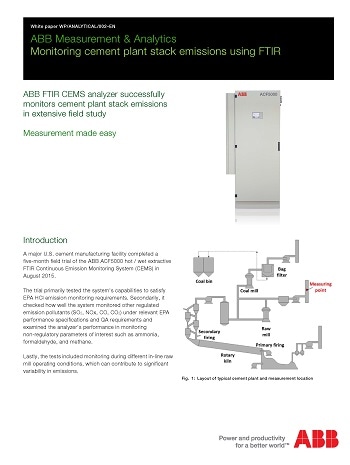ABB’s Measurement & Analytics business announces the availability of an eight-page white paper describing the results of an extensive field evaluation of a FTIR based continuous emission monitoring system (CEMS) at a major U.S. cement plant.

The trial primarily tested whether the system could satisfactorily measure HCl emissions to meet EPA regulatory requirements. Since the system can simultaneously measure up to 15 components, the trials also checked how well it monitored other regulated and non-regulated emission pollutants.
The white paper initially describes the analyzer system, called the ACF5000. A novel design ensures the temperature of the sampling system from stack to analyzer is maintained above 180°C (356°F) to permit measurement of low concentrations of reactive pollutants such as hydrogen chloride and ammonia. A series of validation cells can be rotated into the spectrometer's beam path to minimize the need for test calibration gases.
According to the white paper, the ACF5000 system provided highly reliable HCl monitoring data to meet the initial certification and on-going QA requirements for portland cement plants subject to EPA 40CFR63 Subpart LLL regulations during all in-line raw mill operating conditions. It also made reliable measurements of all other pollutant components of interest.
The white paper, which includes diagrams, a table, and graphic readouts of measured data, concludes that the analyzer completed its commissioning and operated for several months without any apparent problems. To download a copy of the white paper, entitled "ABB FTIR CEMS analyzer successfully monitors cement plant stack emissions in extensive field study," please contact us.